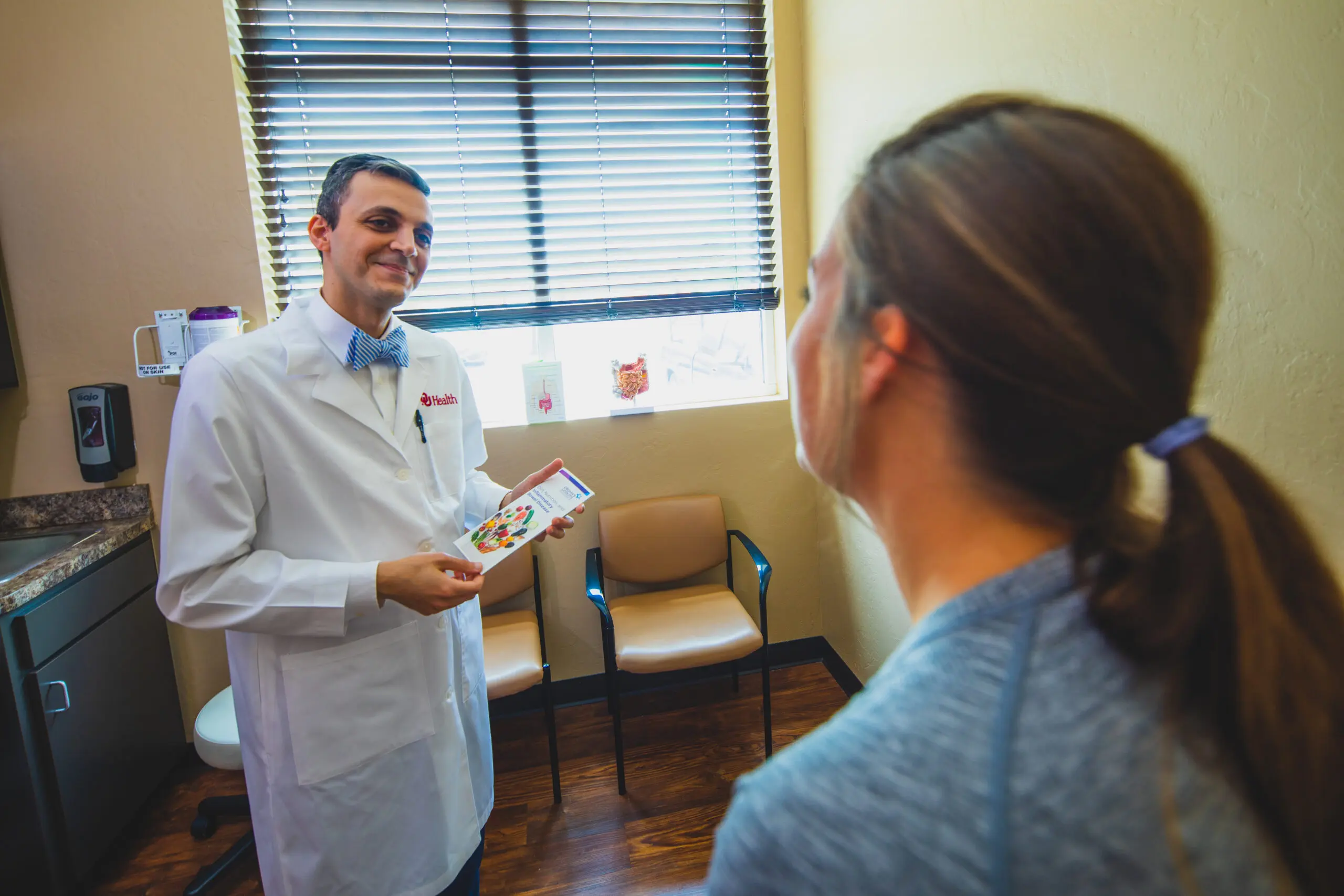The alarm clock wakes Dr. Frank Fore at 5:30 every weekday morning, and the whirlwind day for this cardiovascular surgeon with St. John Health System in Tulsa is off and running. He’s making rounds by 6:15, checking in on patients and monitoring their treatment and progress. The surgery schedule starts at 7, and, after a few interviews and consultations, Fore is in the operating theater at 7:15. Typically, he does two procedures per day. These are often complicated operations, such as coronary bypass, aortic valve replacement or repairing an aneurysm with a graft, and each may take anywhere from three to five hours. He’s usually done in the operating room by 4 or 5 p.m., but his grueling, physically and mentally demanding day isn’t over; he’s off for his second set of rounds to check in on patients again before his 12-to-14-hour day is complete.
Dr. Arielle Allen is up every day at 3 or 4 a.m. Granted, that’s because she’s up with her 7-month-old baby. Before becoming a mother, she might get to sleep in as late as 5. A urogynocologist with INTEGRIS Health in Oklahoma City, Allen specializes in female pelvic health with her surgical practice centered on the repair of pelvic floor dysfunctions, such as incontinence and prolapse. She also performs hysterectomies and has received specialized training in the repair of complications related to pelvic mesh.
Allen is scrubbed in and in surgery by 7:30, and she will do three to four operations separated by only a short, 30-to-45-minute window to clean the operating room from floor to ceiling and prepare for the next procedure. Each of these complex operations, often completed with the help of a robot, may take three to four hours.
Dr. Michael Thomas is the chair of the Department of Surgery at Oklahoma State University Medical Center and OSU Center for Health Sciences. In addition to his duties training surgery residents and medical students, Thomas’ 60-to-80-hour week also includes the duties of a practicing general surgeon who performs operations at OSU Medical Center, Saint Francis and Cancer Treatment Centers of America.
To someone with a doctor’s appointment, surgery is perhaps the most frightening word in the English language, and to most, surgeons are the most mysterious of medical professionals. For one, it’s very difficult for someone on the outside to truly understand what a surgeon does. For most surgeons, life bears no resemblance to the jet-setting doctors of The Real Housewives genre or the drama of Grey’s Anatomy. Society places them on a pedestal as something more than mere mortals, and some may even perpetuate that myth, but by and large surgeons are ordinary people who know how to do extraordinary things.
“I love playing music in the operating room, calming music like Coldplay, U2 or OneRepublic. It helps me focus.” – Dr. Arielle Allen, INTEGRIS Health.
Becoming A Surgeon
Surgeons, like all physicians, complete an undergraduate degree, four years of medical school and a residency program. For most, a residency is at least five years, but some specialties may require even more training.
“I’m 35. That may sound old, but for a surgeon that’s not abnormal,” says Allen.
Allen has just finished 15 years of higher education, including a four-year OBGYN residency and a three-year fellowship in her specialty.
“Technically, I’ve never done surgery truly on my own, but I’ve done hundreds of surgeries,” says Allen. Though she’s a recognized expert and sought-after robotic surgeon, in a sense, she’s just beginning her surgical career.
“I’ve been a surgeon for a long time,” says Fore. “When I got into medical school, it was 1970 and cardiac surgery was really in its infancy. I wanted to do the new thing and go as far as I could in a profession, and at that time it was cardiac surgery.”
For Fore, that meant a bit of bouncing around the country, which wasn’t at all uncommon at that time. He completed four years of medical school at the University of Texas at Galveston as well as a year-long surgical internship, followed by a year-long internship at OU. Then he was off to Hawaii to do research on baboons.
“At that time you had to do research to be a cardiac surgeon,” says Fore. From there, Fore lobbied to return to Oklahoma.
“I chose OU because they were on call every night. I figured if you did more surgery, you got more experience.”
He completed two years of residency, including a year as chief surgical resident. He would have stuck around longer had the Red River rivalry not come into play.
“I wasn’t an Oklahoma boy, and there were lots of other people who wanted (the position.),” says the native Texan.
He was chief surgical resident in Virginia for a year, and then a mentor helped him land a coveted spot at UCLA where they had pioneered cardioplegia, a now-commonplace means of protecting the heart during open-heart surgery. Two years at UCLA, including a year as chief resident, completed Fore’s seven-year post-medical school odyssey, and he was finally ready to begin his surgical career as an attending physician.
In Residence
Residency and other post-medical school surgical training all lead up to the day you are called attending, and it’s a carefully planned and orchestrated process.
“Residency is about graduated increases in responsibility,” says Dr. Russell Postier, professor and chair of the surgery department at the OU College of Medicine.
Postier, who has been teaching young surgeons for nearly 32 years, says the first year of residency teaches the care of critically ill patients along with some surgery. By the end of that year, he says, young surgeons are pretty much ready to operate on their own.
“You’ve learned management skills and teaching skills,” he says. “You’ve learned to be conservative, but also when to be more aggressive.”
He says the most important thing residents learn during this period, however, is judgment, and to acquire judgment requires autonomy. Thus attending lead surgeons teach by leading residents to the correct answer.
“If a resident has a question, the attending doesn’t tell them the answer,” he says. “They ask the resident what they think and help them use their own judgment to arrive at the correct answer.”
One of Allen’s early and most vivid operating room memories proves the importance of this training and the skills and judgment honed during residency. It was her first time to operate without an attending.
“It was an urgent C-section,” she says, “what we call a crash C-section. It needed to be performed then and there to save the baby and there literally wasn’t time for the attending to scrub in. So, I performed the surgery with another resident.” Both mother and baby were fine, she adds.
Allen’s performance also reveals another byproduct of training. She says she wasn’t at all scared or nervous.
“I love working with computers, building computers. I takes my mind away from surgery.” – Dr. Michael Thomas, OSU Medical Center
“The shock hit me afterwards, but because of my training I was able to perform without fear,” she says. “The intensity of the situation and the shaking hit me after.”
According to Allen, this all-important judgment described by Postier comes into play every time a surgeon enters the operating room.
“Every surgery is different, and you have to think on your feet. Two seemingly identical procedures can have a different set of complications,” says Allen. “Being able to adapt has made me a better surgeon.”
Postier feels that recent regulations make teaching residents to have autonomy a challenge.
“Hours restrictions have made surgical training better and worse,” he says. “When I was a resident, I worked every day and every other night.”
Under current standards, residents may work a maximum of 80 hours per week, and they must have at least one 24-hour period off each week. On the plus side, advocates of hours restriction say you have fewer burnt-out, sleep-deprived physicians making life and death decisions, and Postier is quick to point out that the restrictions allow residents to have more of a life outside the hospital. However, Postier says that prior to these restrictions, students had more of an opportunity to make their own decisions regarding patient care, which he believes leads to the ability to make good choices.
While Postier doesn’t say that patient care is affected by these regulations, he says it does affect a resident’s ability to be involved in follow up care to the degree they might like. If a resident works in excess of their 80 hours or during their day off, they’ve violated the rules, but they may feel obligated to the patient.
“Eighty hours is not an unreasonable restriction,” says Postier. “But if a resident wants to work beyond that within reason, I think they should be allowed to do so.”
Passion
Passion is the common denominator that binds all surgeons. Clearly you have to have passion to endure the rigors of training required to be a surgeon, and then that passion must sustain you through a demanding career. That passion is usually evident early in a physician’s career.
“Some students who go into surgery come to medical school with a clear-cut idea of what they want to do, and it doesn’t change. Some don’t have any idea, but when they get into the operating room they fall in love with it,” says Postier.
He says less than seven percent of medical students pursue a career in surgery, and most other students find the operating room a scary place. However, to those for whom it becomes a career, the operating room can be comforting.
“Medical students make this decision because they really love it,” says Postier. “You have to believe you can do anything.”
Allen says that she’s most comfortable when she’s in the operating room and that surgery clicked for her early in medical school.
“I love performing surgical procedures, and I love improving a patient’s quality of life,” she says. “When I did my general surgery rotation during medical school, I loved it.”
Fore’s passion for surgery made him seek out more time in the operating room, soaking up everything he could learn from those around him. Of course, he describes a different era in resident training.
“Surgery was very different then. There weren’t any restrictions on hours,” he says. “I was taught by other residents, not attendings.
“I just thought it was the best thing in the world. The more you knew the more you got to operate.”
Common Bonds
In addition to the passion that drives surgeons, there are a number of commonalities that come up when they discuss what they believe makes one a good surgeon.
On the practical side, Postier says surgeons have to like the operating room, they have to like dealing with sick patients and they have to like working with a team.
While this may seem obvious, it isn’t unheard of for residents to discover they simply don’t have the chops for these three things.
“I’ve not seen a resident that we couldn’t teach to operate,” he says. “Generally people who drop out, it’s because maybe they liked one aspect, but really didn’t like another.”
He goes on to tell the story of a fourth-year resident who finally came to the conclusion that the operating room frightened him and he didn’t like dealing with very sick patients.
“June 30 is your last day as a resident. On July 1 you’re an attending and you can do anything the hospital will allow.” – Dr. Russell Postier, OU College of Medicine
“We had no idea. We didn’t pick up that he didn’t like the OR or critical care,” says Postier. “He became an anesthesiologist.”
Work ethic is another term that comes up often when asked about the qualities of a good surgeon.
“There are a lot of personalities, but surgeons have to be ready to work a lot,” says Fore. “An emergency case can last three to five hours, and there’s no stopping.”
“When you opt to become a surgeon, you’ve joined the Marines,” says Postier, “not the Coast Guard, but the Marines. You must have dedication.”
Personality also comes into play.
“I’m very particular and have a heightened attention to detail,” says Allen. “I think that’s what makes a good surgeon. Surgeons have to have focus.”
Fore concurs, adding that he likes technical things.
“I would be very bored sitting in an office all day,” he says.
Why They Do It
It takes many years and typically a mountain of student loan debt to become a surgeon, and once you’re done you’ve entered a profession with extremely demanding hours and a paycheck that often isn’t what it used to be. So, why would anyone do it? One word: patients.
Surgeons have a unique opportunity to change a patient’s life, to hopefully improve the quality of life, and that is the universal driving force behind what every surgeon does.
“The patient always comes first. I think every physician will say that. It’s ingrained,” says Fore.
“It’s so gratifying to have a patient thank me. That’s why I’m doing it,” says Allen. “If a patient doesn’t thank me or is unhappy it ruins my day.”
A desire to better serve patients led Dr. John Frame of Breast Health Specialists of Oklahoma to refine his practice and his entire approach to care. Frame, who started out in general surgery, had always performed a high number of breast surgeries.
“I started seeing more and more women with breast problems and breast cancer in particular,” says Frame. “I found an intense interest in being able to shepherd women through that process.”
One patient in particular left an indelible mark on Frame and fundamentally changed his outlook. It was a breast cancer patient whom Frame had successfully treated. However, after the treatment was over, she shared the journal she kept during the process. This eye-opening experience revealed a patient that was an emotional wreck.
Frame eventually opened his own clinic and switched to an office-based approach to managing breast health with an emphasis on compassion and emotional support. When surgery is needed, he has privileges at local hospitals, such as Saint Francis, but he tries to avoid long hospital stays.
“I’ve become much more comprehensive in my approach to providing support, and I’m always trying to make my team mindful that we need to reduce time spent waiting – that’s when patients get anxious,” he says.
In cases of breast cancer, Frame takes on a role not traditionally associated with surgeons. He performs surgery when needed, but he also steers patients through chemotherapy, hormone therapy and other treatments, such as nutrition, counseling and physical therapy.
“I have a talent for what I do, and it’s not a surgical talent, it’s a relationship talent and a talent for establishing trust. My patients recognize that, and after they’ve completed their journey, they’re appreciative of that,” says Frame.
A Field In Flux
Surgery is actually an ancient practice. In prehistoric Europe and Mesoamerica, early surgeons drilled holes in patients’ skulls to relieve pressure and treat various disorders and perhaps release a few demons. Ancient texts from India and Egypt reveal complex surgical practices for the time. Ancient Greeks and Chinese performed surgery with the aid of early anesthesia, and the highly advanced Islamic world of the Middle Ages developed surgical techniques that would be practiced throughout Europe until the Renaissance. Europeans began to make surgery an academic pursuit in the Middle Ages, but you might very well have had surgery performed by the same guy who gave you a shave and haircut.
Surgery developed rapidly with the scientific era and, not coincidentally, the beginnings of modern warfare. Three major advances allowed modern surgery to advance beyond amputation and cauterization: control of bleeding, anesthesia and means of controlling infection. These practices, which are being improved upon to this day, set the stage for the incredible complexity and specialization we see in surgery today.
The practice of surgery has always been focused on development of new and better techniques and better outcomes for patients. When you ask today’s surgeons about the advances that have had the biggest impact on their practice, they’re almost entirely centered on modern technology.
As Fore says, there are millions of little things that have improved surgery and patient outcomes and allowed surgeons to be more effective. However, three major advances stand out.
Perhaps most influential is the advancement of minimally invasive surgical techniques, which are widely practiced in nearly every specialty. Any surgery causes trauma, blood loss and other damage to the body, and the more invasive the surgery the more the patient is at risk and the longer the recovery. Thus, surgical advances of recent years have focused on doing more through increasingly fewer and increasingly smaller incisions.
“The concept of minimally invasive surgery has allowed us to treat patients more effectively with much quicker recovery and less postoperative pain,” says Dr. John King, a general surgeon with Warren Clinic in Tulsa.
“It’s a great privilege to perform surgery. I’ve always appreciated that someone will lie down and go to sleep and let me whittle on them.” – Dr. Frank Fore, St. John Health System
“One of the most dramatic changes in my practice is the placement of endografts using small incisions in the groin,” says Fore of a procedure used to repair the aorta through a catheter in the patient’s groin.
Postier points to a still experimental surgical technique that may further advance minimally invasive surgery. NOTES, or natural orifice translumenal endoscopic surgery, allows the surgeon to enter the patient’s body through its natural orifices, the mouth for instance, and perform abdominal surgeries with no external incision – and no visible scar.
Another major surgical advance of recent years is the use of robotic devices to perform or assist surgeries. Robots enhance the ability to perform minimally invasive procedures and perform surgery on a smaller and smaller scale.
The Intuitive surgical robot is a big part of Allen’s practice, allowing her to do complex operations that once required a large abdominal incision with tiny incisions. She gives the example of sacrocolpopexy, a procedure to repair pelvic organ prolapse. This surgery traditionally yielded better results when performed abdominally, but the incisions were large and made for a long recovery. Robotic surgery allows Allen to repair the condition through a series of one-centimeter incisions.
“Outcomes and recovery times have improved immensely thanks to the robot,” says Allen. “What once required a lengthy hospital stay now only takes one or two days before a patient is up walking around and ready to recover at home.”
Allen is a huge proponent of the robot, adding that the current generation of robot allows her to see in 3-D in places where she could never see with the naked eye.
“It’s amazing how precise you can get, and that reduces bleeding and improves outcomes,” she says.
Robotics has had a huge impact in many surgical specialties, but Postier says its application is currently limited.
“The robot doesn’t have much of a place in general surgery,” he says. “There’s not much that you can do better right now.”
He says the jury is still out on whether or not robotics truly yields better outcomes, adding that they are very expensive. Still, OU does have a robot available for surgical training.
Fore says that robots haven’t been used for as long or as extensively in cardiac surgery largely because of the sensitivity of the heart, but he believes the technology has great potential.
“Robotics is better because of improved visualization,” he says. “It takes the tremor out of surgery (referring to the robot’s ability to filter out and remove the slightest shaking of a surgeon’s hand). You can see in tinier places, you can get within millimeters. I never imagined we would be using robots, but people are now using robots for bypasses.”
Information technology is revolutionizing surgery and medicine in general much as it is every aspect of life. The smartphones and tablets many of us carry around are literally changing the face of medicine for the better.
Postier sees this as one of the major advances of recent years.
“Today residents can sit in conference and do a literature search,” he says. “They can review x-rays and monitor vital signs remotely. The availability of information is just incredible.”
Both Postier and Thomas note that students and surgeons alike can now carry around entire reference books on their iPads. Thomas adds that the power of smartphones and tablets in medicine is exploding as developers create applications specifically for the field.
He also points to the upcoming implementation of universal electronic medical records as an application of information technology that will have a profound effect on surgery. He says, beginning next year, the maintenance of medical records will be done with computers or tablets, improving accuracy and the sharing of information.
“It should be a very beneficial thing,” he says.
The God Complex
“Surgeons are viewed by the public as arrogant. My wife would agree,” says Postier.
Even though we put surgeons on a pedestal, or perhaps because of it, the profession suffers from a bit of an image problem, one to which most surgeons are sensitive. Surgeons are often described as people who think they’re gods, even by other physicians. We see them as unapproachable, fabulously wealthy and more sophisticated than the rest of us. Perhaps surgeons were once the bad boys of medicine. A day in this world might have involved whisking into the operating room to perform a life saving operation, seducing a couple of nurses on the way to a three martini lunch and finishing out the day on the golf course. Clearly, if this myth were ever anything but that, those days are over, and surgeons are quick to set the record straight.
“It’s not a glorious occupation with Grey’s Anatomy type drama,” says King.
“Surgeons are not cowboys,” says Postier. “I don’t think they shoot from the hip like people think. They are gentlemen and gentlewomen – they are not technicians.”
“I think the biggest misconception is that we don’t work hard and make tons of money,” says Allen. “That’s not true at all. My husband is a surgeon, too. We barely see each other and live in a 2,000 square foot house.”
“I made the most money my first year of private practice, and it’s gone down every year,” says Fore.
Allen also takes issue with the idea of surgeons being cold and unapproachable. She says the surgeons she works with have excellent bedside manner and that communication and establishing a relationship with patients is an integral part of modern surgery. This is something Postier points to as well. We may think surgeons do the operation and move on, but he says he has many patients for whom he has provided follow up care years after the initial surgery, and that isn’t uncommon.
Lastly, as a public service, if you the patient have to spend an inordinate amount of time in the waiting room, surgeons want you to know they don’t like that any more than you do.
“We’re not out playing golf,” says Fore. “We can’t always manage our schedule. I feel bad when people are uncomfortable.”





















